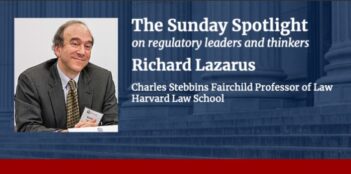
Despite its wide-ranging capabilities, OSHA has often let its detractors have their way. To combat this, it should enlist partners in all directions.
The rising tides of environmental and safety improvements have done relatively little to lift the boats of workers, who still face injury and illness risks far above what we have come to expect elsewhere in society. Yes, outdoor concentrations of major air and water pollutants have fallen to one-half—and in some cases one-tenth—of their levels in 1970 (the year the U.S Occupational Safety and Health Administration (OSHA) and the U.S. Environmental Protection Agency (EPA) were both created), automobiles have required more safety features each model year, and enclosed public and private spaces are now rarely rife with tobacco smoke. But these success stories and others either stop at the workplace door or include workplaces only as an afterthought.
Although the number of fatal occupational accidents is falling (and lately almost imperceptibly slowly), occupational disease has become the ninth leading cause of premature death in the nation, with various estimates agreeing that the death toll from occupational disease exceeds 50,000 per year. While OSHA has only regulated two hazardous substances in the past 19 years, and only 18 substances in its entire 46-year history, the German equivalent of OSHA has set exposure limits for more than 1,000 substances. In a bid to address its unfinished safety and health agenda, OSHA has taken some important steps in the last 12 months—notably the passage of a final rule that imposes requirements on a small subset of firms to report injuries electronically, and the issuing of a long-awaited silica regulation. But these measures look less impressive when viewed as the bulk of the regulatory output of an eight-year administration.
There is no question that OSHA faces a gauntlet of shrill opposition, benign neglect, and false friends. The agency depends on steady appropriations from Congress, many of whose members get teary-eyed at the thought of “job creators” having to moderate their pursuit of profit and follow some rules, but who have little sympathy for bereaved families or the fiscal costs of chronic disease. It has to cajole support from an electorate that mistakenly assumes workers knowingly and voluntarily assume high risks in return for “wage premiums,” and which is happy to support expensive regulations to further clean up community environments and preserve distant wilderness areas. And OSHA relies in vain on being tugged proportionately “from the left” by a declining union movement, whose zeal ebbs further when regulatory controls might shift jobs away from antiquated or unsafe processes that both management and labor want to keep afloat.
But there is also no question that Congress and the courts intended for OSHA to be far more effective and more the master of its own fate than the agency is at present. I suspect few readers are aware, in fact, that judicial interpretations of the Occupational Safety and Health Act of 1970 explicitly allow OSHA to:
- reduce lifetime excess risks of chronic disease to far below one chance in 1,000, even if there are as few as several hundred exposed workers nationwide;
- impose costs high enough to threaten some firms’ viability, so long as the costs do not “threaten the competitive stability of an industry” as a whole;
- impose a “general duty” on employers to remedy safety or health hazards even when no specific OSHA regulations exist, or even when obviously weak and antiquated rules apply;
- force industries, if necessary, to install novel risk-reducing technologies that go “beyond what the industry is presently capable of producing”; and
- change the fundamental nature of certain jobs (for example, as a result of OSHA’s Grain Handling Facilities standard, farms can no longer employ people to do the dangerous task of walking on grain stored within silos to loosen the product).
Given its wide-ranging capabilities, why has OSHA so often let its detractors have their way and let a blasé public continue to avert its eyes from hazards known for centuries to be needlessly dangerous? Having worked for and with OSHA and other federal agencies, advised city and state regulators, and recently been part of a year-long project to define and promote “regulatory excellence,” I think the answers often lie within the walls of my former agency. Under leaders of both parties, OSHA defends its won-lost percentage, its turf, and (sometimes) its career managers much more energetically than it empowers its superb rule-writers and onsite inspectors, and more than it pursues cutting-edge science and stringent standards.
For one concrete example, consider the 2006 OSHA standard for hexavalent chromium, a human carcinogen. In 1998, when I was still working at the agency, our chief lawyer came in waving news of our “victory” in court that allowed us to shelve the promised rule. Here, the principle that “no one can tell us what to do” trumped the idea that perhaps we should use our reaffirmed discretion to accelerate the slow pace of this needed rule. Then, the final rule, which was issued only after a second court decision excoriated OSHA for further delay, was so weak that it allowed about 85 percent of all establishments to increase chromium levels. OSHA’s new silica standard looks eerily similar in this regard. I find it depressing that an agency with the authorities granted above declares “mission accomplished” with rules that enshrine excess cancer risks exceeding one chance per 100, and refuses to impose costs that exceed 1 percent of any firm’s revenue.
I am not recommending that OSHA simply become oppositional or shrill for its own sake, just because it faces unreasonable opposition. The agency’s personnel are all public servants, and they must always listen respectfully to the citizens they work for. And there are some battles that cannot be won, or that can only be won with scorched earth as the result. But the cycle of meekness and deference—what another observer has aptly called “learned helplessness”—seems to embolden many of OSHA’s opponents, whose increasingly outsized expectations create in turn a yet more timid and depressed agency workforce. In OSHA’s strongest (albeit brief) periods of activity, it knew when to respectfully assert that the science, economics, and law were all on the side of policies that gave workers the protections they deserve in our great society.
The best strategy for an overmatched regulator is to enlist partners in all directions. OSHA should involve other federal, state, and local regulators—and concerned citizens—as “eyes and ears” to lead its inspectors to serious hazards. It should work with the roughly 15 non-union National Council for Occupational Safety and Health groups to insist that proven technologies required to protect the public also diffuse into the workplace, where risks are higher. Rear-view cameras, for instance, are required in all new passenger cars, but not in trucks and forklifts that often cause backover fatalities at work; the work of “COSH” groups and other partners could help redress such discrepancies.
Finally, OSHA should prod the best firms to evangelize for health and safety among their customers, suppliers, colleagues, and competitors. In 2000, an advocacy group convinced McDonald’s to stop buying meat from slaughterhouses that did not treat their animals humanely. And more recently, Walmart and other companies stopped buying eggs from caged hens, citing concerns about animal welfare—but possibly increasing worker injuries and illnesses in the process. The only reason that companies like these do not also take pride in purchasing from and selling to companies who treat their workers humanely is that OSHA is satisfied to tie one hand behind its own back and bemoan its lack of reach.
This essay is adapted from an essay that originally appeared in the September/October 2016 issue of The Environmental Forum, the Environmental Law Institute’s monthly magazine. Professor Finkel penned the essay for the Forum in response to the magazine’s invitation to contribute to its debate, along with five other invited participants, addressing the question: Is OSHA a Failed Agency—Or an Unheralded Success?




